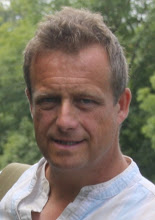Llangollen in cool rain; a stone and red brick town, squeezed by steep wooded hills, so that the houses seem pushed to the river and the famous bridge seems like an arm from either side stretched across to stabilise the houses. The drizzle of water on old stone.
The first time I have driven here, the steep pull up out of the town to the graveyard at the top of the hill, yet a route familiar, brain-etched from a hundred visits; the English names fading as we turn from the guest houses lining the road to Plas Newydd onto the tiny road of Fron Bache, a sunny silent place of 1930s respectability, pebble-dashing and bay windows, the feeling of an endless afternoon. Dorothy and Gwynneth used to walk up here with the Llangollen family, Auntie Bessie and the boys, Arthur and Ernest and Glynne. The road is rough and feels more like a farm road, a hill-road, a rough Welsh hill man in town for the market; but now the modern houses are creeping up the side, Llangollen’s anywhere suburbs, modern raw houses on what was a shaggy, gloomy playing field, hill-fields, openness; as they were when Dorothy first walked up this lane, this slow spread of the town, a rural speed of encroachment; new houses have even swallowed the kink in the road where the family used to rest on the bench with the view back down the hill, the road lined with poppies and escaped garden flowers.
The cemetery on Fron Bache is on the hillside, the fron bache, corrupted, fading Welsh, next to an allotment, with a tumble of town roofs below it, the pinned curve of the permanent Eisteddfod stage, a harsh redbrick row of houses slammed unsympathetically into the hillside. And a wary ring of more new houses, pebble-dashed and hanging-basketed, a riot of Georgian lamps and security lights; but it is still a place of yews and damp grass, wild flowers and benign neglect. Ilid and Bessie’s gravestone has fallen over or been laid to rest, lead letters scattered, dates difficult to make out. Lost afternoons in the 1960s, family events, funerals, weddings, small parties; why was I here, asks Reg, did I come to… As if the dates only existed to support a funeral, a party, a birth.
Further down the hill, right at the last yew, the path uneven and overgrown, dotted with wildflowers, lie William Eyton Jones and his wife Janet, my grandparents, the Welsh grandfather I never knew; and his parents David and Ann, an English inscription despite their Welsh language, a fading of national identity behind a British mask. A peaceful quiet place, somewhere I have never seen another soul, a place of pheasants, silence, wild flowers, grasses, the distant steam whistle urgent from the railway.
Back in the town, a pattern of streets and awkward conversations with curious bystanders, an occupational hazard. Market Street and West Street, the undiscovered site of Cambrian Cottages; addresses for David Jones, my great-grandfather, this census migration through the town, a journey plotted at ten-yearly intervals. Decades walked through or past, addresses known and unknown; the history of streets, the shifts of buildings. Chapel Street in the 1870s, the tantalising possibility of ‘Oak Street’ in the 1840s; lunch in the Hand to take stock and curb our enthusiasm.
Thursday, 18 December 2008
Subscribe to:
Post Comments (Atom)

No comments:
Post a Comment